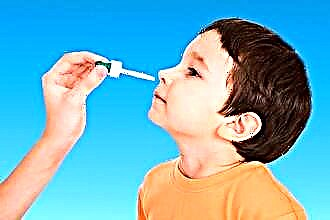Diphtheria refers to infectious diseases, the development of which is caused by infection of the body with bacteria. Pathology is characterized by the appearance of a film plaque on the surface of the affected organs, for example, in the oropharynx, nasal passages, eyes or auricle. To make a diagnosis if an infectious disease is suspected, the doctor directs the patient for a swab for diphtheria from the nose and throat.
 It is possible to suspect the activation of Leffler's rod (the initiator of the development of diphtheria) on the basis of some symptoms:
It is possible to suspect the activation of Leffler's rod (the initiator of the development of diphtheria) on the basis of some symptoms:
- acute onset;
- febrile hyperthermia, when the temperature exceeds 38 degrees;
- cephalalgia (headaches);
- malaise;
- cardiopalmus;
- lymphadenitis, in which the lymph nodes located close to the inflammatory focus increase in diameter, when palpated they become painful, compacted.
After 3 days from the onset of the disease, the temperature drops to subfebrile levels, and the fibrinous films thicken, acquire a pearlescent color.
Do not try to remove the films from the tonsils, nose yourself. This leads to exposure of the wound surface and the appearance of bleeding.
We emphasize that there is a toxic form of the disease. She is characterized by hectic fever, severe weakness. A sign of the progression of respiratory, cardiac insufficiency is the appearance of acrocyanosis (blue discoloration of the ears, nose, nasolabial area, fingers), as well as a decrease in blood pressure and an increase in tachycardia.
In this case, the patient may be disturbed by hallucinations, as a manifestation of intoxication, hypoxic damage to the structures of the brain. There is also agitation, nausea, nasal voice, shortness of breath, shortness of breath and swelling of the neck.
Diphtheria toxin leads to the development of croup when the trachea and bronchial tree are affected. Symptomatically, the pathology is manifested by a barking cough, which gradually becomes silent and asphyxia develops.
Due to the high toxicity of the pathogen in childhood, vaccination is carried out, followed by revaccination. Untimely treatment of the disease leads to the development of:
- infectious toxic shock;
- asphyxia;
- renal dysfunction (nephrosis, renal failure);
- nerve damage;
- myocarditis;
- multiple organ failure (with toxic and hypertoxic forms).
Indications for analysis
In some cases, a smear for diphtheria and other pathogenic flora is carried out if the development of the disease is suspected. However, for prophylactic purposes, the study is shown:
- for employment in medical, childcare facilities, in the food sector;
- before visiting educational institutions;
- pregnant women to determine the risk of possible complications;
- after contact with a sick person;
- for the selection of drug therapy.
Thus, preventive research makes it possible to prevent the development of epidemics associated with the spread of infectious pathogens.
Diagnostic features
There are several strains of Leffler's bacillus. They differ in cultural, structural and enzymatic properties. To confirm the diagnosis, the doctor is tested for bacterial diphtheria. Examining the material, the specialist discovers Leffler's bacillus, which, in combination with the clinical picture, is a reliable factor in the disease.
It may take up to half a day to detect an infectious agent, provided that the patient has not taken medications.
 When a throat swab is taken against the background of antibiotic therapy, bacterial growth is significantly slowed down, and the diagnostic results are not considered reliable. In this case, it is advisable to use serological research methods.
When a throat swab is taken against the background of antibiotic therapy, bacterial growth is significantly slowed down, and the diagnostic results are not considered reliable. In this case, it is advisable to use serological research methods.
Most often, RPHA is prescribed for this, which is carried out within the first 3 days and after a week of diagnosis. The diagnostic method makes it possible to detect antibodies to the toxin of the diphtheria bacterium. A positive result is noted with an increase in antibodies by 4 or more times. Thus, people with low levels of immune defense against diphtheria toxin can be found.
In the absence of antibodies to diphtheria toxin, vaccination is performed using DTP.
Preparing for the smear test
When a diphtheria smear is required, we will analyze how to take the test a little later. Now let's dwell on the preparatory stage. It includes:
- stop taking antibacterial drugs 10 days before diagnosis;
- the use of solutions for rinsing the oral cavity, oropharynx with antiseptic components is prohibited 5 days before the study;
- the analysis is given on an empty stomach;
- it is not recommended to brush your teeth on the day of diagnosis.
Material intake
The necessary material for diagnosis is taken from the pharynx and nose. First, the patient tilts his head back,  opens the mouth as wide as possible. The specialist fixes the tongue with a metal or wooden plaster, taking it to the bottom of the mouth.
opens the mouth as wide as possible. The specialist fixes the tongue with a metal or wooden plaster, taking it to the bottom of the mouth.
With a sterile swab on an elongated loop, the specialist conducts the mucous membrane of the oropharynx. During the insertion and removal of the tampon from the oral cavity, it should not come into contact with other surfaces. The material on the swab is lowered into a test tube, thanks to which it is transported to the laboratory without damage or death of microbes.
The collected material should be sown in the first 2 hours. In the process of taking the material, a person may experience discomfort or an urge to vomit (especially those patients who have an increased gag reflex).
Next, the doctor proceeds to take a swab from the nasal passage. To do this, the patient also tilts his head back, the nasal passage is cleared of mucus, and the skin is treated with alcohol.
A sterile tampon on an elongated loop must be inserted alternately into the nasal passages, in close contact with the surface of the mucous membrane. After that, the swab is lowered into a sterile tube and sent to the laboratory.
Microscopic examination
The material taken from the oropharynx is subjected to microscopy. To do this, the doctor applies it to a glass slide, stains it with special dyes and examines the cellular composition.
The morphological features of diphtheria bacillus are so different that microscopy is used as a preliminary study before inoculation. It makes it possible to analyze the composition of the flora. Coloring can be done according to Gram, Leffler (the most informative, often used) and Neisser.
In smears, diphtheria sticks are positioned like the Roman numeral 5.
Sowing material

To ensure optimal conditions for the growth and reproduction of bacteria, it is necessary to select a special nutrient medium. Inoculation for diphtheria is carried out in a sterile box on rolled Ru serum, tellurite differs, serum / blood tellurite agar or Clauberg's medium.
The material is placed in a medium, then scattered over the surface. For this, a Petri dish is used. The incubation of crops is carried out in a thermostat. The growth and nature of the growing colonies are monitored daily. In order to isolate a pure culture, colonies are subcultured on selective nutrient media.
Thanks to bacterial culture and additional diagnostics, it is possible to confirm the diagnosis of an infectious disease and take timely measures to treat a sick person and prevent the spread of infection among his environment.



